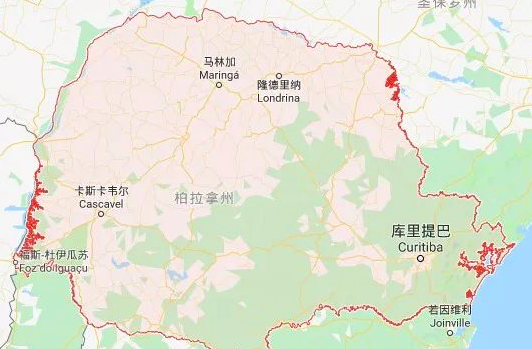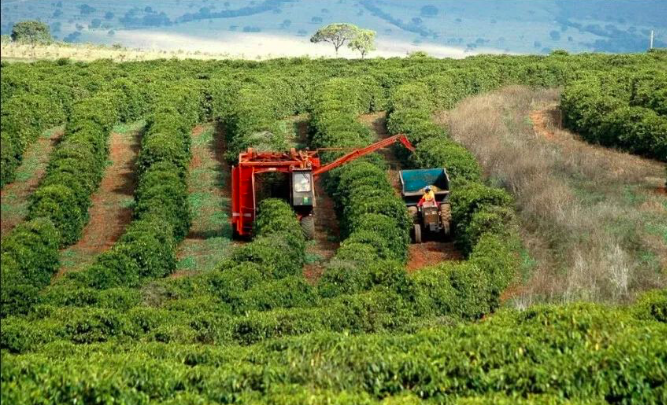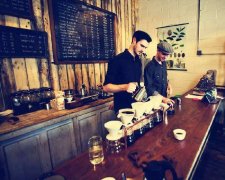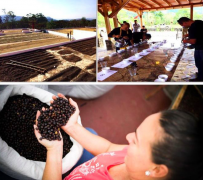Talking about Brazil, a big coffee producer in the world
When it comes to Brazil, everyone can always talk about it. Brazilian football is good. Brazilian coffee is a big coffee producer in the world. Its beans are sour and mild in taste, and its beans are often used to mix and make concentrated beans with nutty aroma in slightly acid. it has a long taste. Today, let's talk about Brazil, a coffee producing region.
Brazil, known as the coffee kingdom, is the world's largest producer and exporter. Coffee production accounts for more than 30% of the world's coffee production. Brazil is also the second coffee consumer after the United States. There are about 300000 farmers engaged in coffee farming here, but coffee is mainly distributed in the south of Brazil. Compared with other coffee-producing countries in Central and South America, Brazilian coffee Most of them are grown in plain areas, and their elevations are obviously low, mostly about 600-1000 meters. Even South Minas, Serrado and Mojiana are rarely 1300 meters. It is also for this reason that Brazilian beans are soft. It does not have the hardness and strong sour taste of high-altitude coffee, so most of its beans are medium-sour, mild and smooth, mellow and sweet. Even if it is mixed with other beans, the taste will not change much.

An introduction to the producing areas of Brazil
Brazil has 26 states and 17 states produce coffee, but seven of them produce the largest, accounting for 98% of the country's total output.
State of Sao Paulo (Mogiana, Centro-Oeste)
State of Parana (Norte Pionerio do Paran á)
Bahia State (Planaltoda Bahia, Cerrado da Bahia, Atlantico Baiano)
Espiritu Santo (Montanhas do Esp í rito Santo, Conilon Capixaba)
Minas Gerais State (Sul de Minas, Cerrado Mineiro, Chapada de Minas, Matas de Minas)
Londonia (Rond?nia)
Rio de Janeiro State (Rio de Janeiro)

Four states, Parana, SaoPaulo, Minas Gerais and EspiritoSanto, account for 80 per cent of total production, while Minas Gerais accounts for the most astonishing 30 per cent of production. The common Santos Santos and Mochiana Mogiana are from S ã o Paulo, Syracuse Cerrado and Minas Sul de Minas in Minas Gerais because of their high altitude and high yield of boutique Brazilian coffee beans. Silado is located to the west of Minas Gerais, a flat plateau at 750m--1200m above sea level.
South Minas is the hilly woodland of 700m-1200m above sea level, and it is the earliest production area of Brazilian coffee. Due to the increase in labor costs, it is now mostly harvested by machinery, and it is also the earliest commercialized area of coffee. We can see many large exporters here. Bahia, located in the north of Brazil, mainly produces washing in Brazil, and Esprito Santo, near the sea, is the main export area of Brazilian Robusta varieties.
S â o Paulo, Sao Paulo State

Morgiana / Mogiana
This area is very close to the south of Minas. Coffee is grown between shrubs, grasslands and other vegetation. There are many farming families in this area, some of which operate in the traditional way of large farms, while others operate in a small-scale and modern way. Modern science and technology mixed with mountain coffee cultivation culture has created the highest quality raw coffee beans.
Centro-Oeste / Midwest
(Gar ç a Marilia and Piraju)
Coffee beans are generally grown in this area by combining large estates with traditional production lines. Although production seems to be declining, it is more pursuing the production of higher quality raw beans.

About the Brazilian Santos
Santos / Santos taste mellow, neutral, can be drunk alone, and mixed with other kinds of coffee beans to form a comprehensive coffee is also a good choice. Santos has no outstanding advantages, but there are no obvious defects, mild and smooth taste, low acidity, moderate mellow, light sweetness, these soft flavors mixed together, to distinguish them one by one, is the best test of the taste buds, which is why many Santos fans love this kind of coffee.
Santos coffee grows in the area of Sao Paulo and is a descendant of Arabica trees from Bourbon Island in the 18th century under the name of export port Santos (Santos). It belongs to the bourbon subspecies (var. Bourbon). Before the age of three to four, bourbon trees bear small, twisted beans, called bourbon Santos, which are more advanced Brazilian beans, usually called "Brazil" directly in cafes. After three or four years old, bourbon trees only produce large, flat beans called "Flat Bean Santos", which are flat in taste and cheap in price.
Paran â Parana
Norte Pionerio do Paran á
The state, which used to be Brazil's largest production region, now has its own unique production technology.
After discovering a decline in the unit yield of coffee woodland, producers in Parana created a new "closed planting system". At present, a large number of coffee trees, seedlings per hectare can better withstand the cold wind, but also ensure a more regular yield.
Bahia, Bahia State
Robusta beans are mainly produced on large farms.
Shapada / Planaltoda Bahia
The area is located in the central state of Bahia and mainly produces hand-screened Arabica coffee. It mainly adopts the method of washing.
Bahia Hilado / Cerrado da Bahia
This area, located in the western state of Bahia, is generally considered to be the latest coffee-growing area in Brazil. Modern technologies for irrigation and harvesting are widely used in this area.
Espirito Santo, Esp í rito Santo
Montanhas do ESP í rito Santo
Conilon Capixaba
The state is mainly divided into two regions: robusta beans are grown on both large and small estates in the north, while typical mountain-grown coffee is grown in the south, which is less common. There are both washing and sun exposure in this area.
South Minas / Sul de Minas
The small manor area produces about 8-10 million bags of coffee beans growing on the mountain. Suitable altitude, undulating terrain and climate conducive to growing coffee, rainfall is concentrated in the months when the fruit needs to grow, and the climate is dry in the months when the harvest is needed.
Syrador / Cerrado Mineiro
Growing coffee in Hirado (also known as Savannah) is a victory for Brazilian coffee technology. More and more large coffee plantations in Syracuse use high technology for production, and this is the case in very few areas. Plateau climate, four distinct seasons, fruit ripening is very stable, in the harvest season is not at all. Savannah coffee is generally treated in the sun, which is also a trend in current processing.

Minas Shapada / Chapada de Minas
In the northern part of Minas Gerais, the area is very small, but the quality of raw beans is among the best in the world.
Mount Minas Gerais / Matas de Minas
It is a very large area with a very diverse ecosystem and is the oldest coffee growing area in Brazil, and its highest altitude is the best area for coffee processing.
Rond ô nia, Londonia
This area mainly produces robusta coffee.
Rio de Janeiro, State of Rio de Janeiro

Mainly grow Arabica species. Compared with other producing areas, it has excellent port traffic advantages.
Varieties of coffee in Brazil
At present, Brazil takes Red Bourbon, Yellow Bourbon, New World and Kaduai as the main varieties. Kaddura, Akaia, Obata, Alamosa, pointed body bourbon and so on have also been planted and studied. Cambinas Agricultural Research Institute in Sao Paulo is a famous coffee variety improvement arsenal in Brazil. Katim, the most widely cultivated in the world, is the masterpiece of Portuguese and Brazilian scientists.

Treatment method
Due to its vast territory and huge output, solarization has long been the main treatment in Brazil, and washing can not support the production of such a large amount of coffee beans. This also gives the industry the habitual thinking of shoddy Brazilian coffee (but it does not mean that all Brazilian coffee is cheap, and the coffee produced by famous estates is also quite good).
Since 1990, half-sun (or semi-water washing) has been advocated in Brazil, that is, after removing defects and floating fruits through a sink, peel, pulp and part of pectin are removed by machine, then washed and finally dried or dried in a drying room. Compared with the water washing method, the half-sun method saves water and labor, which has greatly improved the quality of Brazilian coffee, reversing the bad criticism of Brazilian coffee after years of rough sun exposure.
Grading system
1. Classification according to defect rate
The evaluation method of Brazilian coffee is "deduction method". According to the number of defective beans per 300g of main beans, there are seven levels from No.2 to No. 8, and if the deduction is less than 4, it can be classified as No.2. Not a single defective bean can certainly be called No.1, but this situation is rare, unable to maintain a certain supply, so Brazil set No.2 as the highest level, not No.1.
2. Classify according to the size of legume
Number of mesh: this is a screen based on a scale of 64 inches. The size of the screen is usually 14 mi 20. In addition, it should be noted that the size corresponding to the number of items is the short side of the coffee bean, that is, the "width". The largest number of items of coffee beans in Brazil is 19 mesh, but the yield is not much, so the highest grade is 17 white 18 mesh.
NY.2 SC-17/18
NY.2/3 SC-14/16
NY.3/4 DDQuality
NY.4/5 SC-14/16
3. Cup test quality
Fine cup
Fine
Good cup
Fair cup
Poor cup
Bad cup
FC (Fine Cup) and GC (Good Cup) are more common.
4. Flavor grade
Brazilian coffee beans are classified into five categories according to their flavor levels. They are: Strictly Soft → is very supple, Soft → is very supple, Softish → is a little supple, Hardish → is not palatable, and Rioy → has iodine choking taste.
Brazil extraordinary Cup (COE)
Due to the industrialization of coffee production in Brazil, a large number of cheap and low-quality coffee beans have been produced. In order to increase the income of working people and raise the price to roasters, extraordinary cups came into being.
The extraordinary Cup originated from a United Nations organization that aims to help farmers improve the quality and income of coffee, connect producers and consumers more closely and fully enjoy the fruits of labor. Many estates that faced closure because of low prices at that time were hoping to win the Zhuoyue Cup in order to raise their prices, so they worked hard to improve the quality of coffee beans. Therefore, the extraordinary Cup was originally intended to save the depressed Brazilian coffee industry, but in the end it became the guarantee of our cup.

Brazilian Coffee Association (BSCA)
The Brazilian Fine Coffee Association (BSCA), located in Varginha, South Minas, is a non-profit coffee organization founded by 12 Brazilian coffee producers in 1991. The first Brazilian Coffee Competition (Cup of Excellence) was held in 1999. Over the years, it has been witnessed and coached by testers in the International Cup, and its flavor has gradually reached its peak and is known as the coffee kingdom.
BSCA aims to improve the quality of coffee production in Brazil, to promote the commercialization and industrialization of Brazilian coffee, and to develop ecological agriculture through cooperation between domestic and international organizations to help the sustainable development of coffee growing areas.
Important Notice :
前街咖啡 FrontStreet Coffee has moved to new addredd:
FrontStreet Coffee Address: 315,Donghua East Road,GuangZhou
Tel:020 38364473
- Prev

Barista self-certification | the cancellation of barista professional qualification certificate in China does not mean that the career threshold is low!
Professional coffee knowledge exchange more information about coffee beans Please follow the coffee workshop (Wechat official account cafe_style) baristas are a cool profession, both at home and abroad. Baristas can be said to be a very creative, personalized and skilled profession, so baristas have a lot of personality, they will have cool tattoos and creative patterns.
- Next

Baking curve | how do we determine the baking curve of Costa Rica Phoenix sapphire?
Just on the new Fenghuang Sapphire bean, I also shared about the cooking method of this bean. It is rich in flowers and berries. Today, a friend asked us about a baking curve of this bean. Then I will talk about how to determine the baking curve of this bean in front of the street. Before baking, of course, I need to know a base of this bean.
Related
- Being chased out of the rain in front of Starbucks?! Store: Sheltering from rain under umbrellas poses a safety hazard
- The white moonlight has changed?! Lucky launches "Big Winter Pear American"
- Hand-brewed coffee three-stage method, high-sweet and universal brewing method to share! What does the high sweet water level of hand-brewed coffee mean?
- What is the difference between raw, refined and full espresso coffee? How to extract espresso and taste good?
- A complete list of coffee bean names and their meanings! What is Yejia Shefi coffee? Where is Mantelin coffee?
- What grade does Arida Manor Kaduai coffee beans belong to? What treatment is Arida ASD slow anaerobic sun exposure?
- The milk tea cup becomes smaller?! Overlord Tea Girl launches a new "Return to Yunnan" series
- Accused of selling counterfeit and high-priced coffee beans! Well-known boutique coffee brand "Oukelao" bowed and apologized!
- How to make espresso dumplings? Can I eat coffee and glutinous rice balls together?
- Save the unformed and stagnant powder cakes in one second! What is the problem with stagnant water in the powder bowl of the espresso machine?

